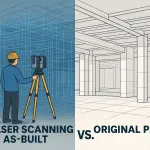You may have heard of Musée Rodin, the famous statue garden in Paris, France. There has been a request for open information and access to 3D scans picked up by 3D laser scanning services and a 3D laser scan device. The museum has denied this request and decided against openly sharing these scans.
3D laser scanning services are used to gather more information on a deeper level and then allow others to understand. It was created to be detail-oriented and create a new way for us to communicate. Many museums share their 3D scans.
Although Musée Rodin did not seem to get the memo about open information and sharing it with others, this is not the first time it has happened. A few years ago, there was a lawsuit for their Egyptian collection and acquiring those 3D scans. That battle was won by Cosmo Wenman, who is once again suing them for denying citizens access to information.
How does 3D laser scanning work?
3D laser scanning services come in many shapes and sizes, and not all work the same. Many times this is a handheld device that takes rapid pictures of an object. A person holding this device will circle the object allowing the scanner to pick up details from every side.
It can sometimes take thousands of pictures per second, ensuring that every piece of important information is picked up. Later this data is sent to a computer, where the images are layered on top of each other to create a complete picture. Then the image is edited to make sure it is as realistic and accurate as possible.
How 3D laser scanning services supposed to be used?
This technology was created in the 1960s, and since then, it has changed drastically. It is no longer for a select group of people. This tool is for anyone thirsty for knowledge. This is one of the best ways to share electronic information and share it worldwide, and that is how it should be used.
It allows people to see objects closer than ever before, being able to zoom in and out. It enables them to create their models based on the information. It can allow students access to things they would never otherwise have access to.
Why should museums adopt this technology?
3D laser scanning has many benefits that other devices would not be able to give a museum. This tool is noninvasive, meaning it won’t harm the objects at all. It is incredibly fast, faster than other ways of taking down information or even trying to replicate copies. Lastly, this device is more precise than doing anything by hand. This makes it one of the best pieces of equipment for a museum to obtain and use.
Final thoughts
3D laser scanning services allow everyone to have access to information up close. Or, it should. This museum has not been upfront and has not allowed many people to view these scans. There is a lawsuit in order because the goal is to provide valuable information to the world, not just a select group.







